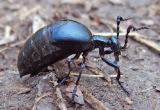
Meloe
Encyclopedia
The blister beetle
genus Meloe is a large, widespread group commonly referred to as oil beetles. They are known as "oil beetles" because they release oily droplets of hemolymph
from their joints when disturbed; this contains cantharidin
, a poisonous chemical causing blistering of the skin and painful swelling. Members of this genus are typically flightless, without functional wings, and shortened elytra.
As in other members of the family, they are hypermetamorphic, going through several larval stages, the first of which is typically a mobile triungulin that finds and attaches to a host in order to gain access to the host's offspring. In this genus, the host is a bee
, and each species of Meloe may attack only a single species or genus of bees; while sometimes considered parasitoid
s, it appears that in general, the Meloe larva consumes the bee larva along with its provisions, and can often survive on the provisions alone, thus they do not truly qualify (see Parasitoid
for definition).
Blister beetle
Blister beetles are beetles of the family Meloidae, so called for their defensive secretion of a blistering agent, cantharidin. There are approximately 7,500 known species worldwide. Many are conspicuous and some aposematically colored, announcing their toxicity to would-be...
genus Meloe is a large, widespread group commonly referred to as oil beetles. They are known as "oil beetles" because they release oily droplets of hemolymph
Hemolymph
Hemolymph, or haemolymph, is a fluid in the circulatory system of some arthropods and is analogous to the fluids and cells making up both blood and interstitial fluid in vertebrates such as birds and mammals...
from their joints when disturbed; this contains cantharidin
Cantharidin
Cantharidin, a type of terpenoid, is a poisonous chemical compound secreted by many species of blister beetle, and most notably by the Spanish fly, Lytta vesicatoria. The false blister beetles and cardinal beetles also have cantharidin.-History:...
, a poisonous chemical causing blistering of the skin and painful swelling. Members of this genus are typically flightless, without functional wings, and shortened elytra.
As in other members of the family, they are hypermetamorphic, going through several larval stages, the first of which is typically a mobile triungulin that finds and attaches to a host in order to gain access to the host's offspring. In this genus, the host is a bee
Bee
Bees are flying insects closely related to wasps and ants, and are known for their role in pollination and for producing honey and beeswax. Bees are a monophyletic lineage within the superfamily Apoidea, presently classified by the unranked taxon name Anthophila...
, and each species of Meloe may attack only a single species or genus of bees; while sometimes considered parasitoid
Parasitoid
A parasitoid is an organism that spends a significant portion of its life history attached to or within a single host organism in a relationship that is in essence parasitic; unlike a true parasite, however, it ultimately sterilises or kills, and sometimes consumes, the host...
s, it appears that in general, the Meloe larva consumes the bee larva along with its provisions, and can often survive on the provisions alone, thus they do not truly qualify (see Parasitoid
Parasitoid
A parasitoid is an organism that spends a significant portion of its life history attached to or within a single host organism in a relationship that is in essence parasitic; unlike a true parasite, however, it ultimately sterilises or kills, and sometimes consumes, the host...
for definition).
Species
Arranged alphabetically.- Meloe americanus Leach, 1815
- Meloe angusticollisMeloe angusticollisThe short-winged blister beetle, or oil beetle, Meloe angusticollis, is a species of blister beetle, native to North America. They average in length....
SayThomas SayThomas Say was an American naturalist, entomologist, malacologist, herpetologist and carcinologist. A taxonomist, he is often considered to be the father of descriptive entomology in the United States. He described more than 1,000 new species of beetles and over 400 species of insects of other...
, 1824 – Short-winged Blister Beetle - Meloe bitoricollis Pinto and Selander, 1970
- Meloe brevicollisMeloe brevicollisMeloe brevicollis is a European oil beetle. It is also known as the "short-necked oil beetle".It had been thought that the beetle had been extinct in the UK since the 1940s, due to intensive farming. However, in 2007 a small population was discovered in south of Devon.In 2010, 40 beetles were found...
Panzer, 1793 – Short-necked Oil Beetle - Meloe californicus Van Dyke, 1928
- Meloe campanicollis Pinto and Selander, 1970
- Meloe carbonaceus LeConte, 1866
- Meloe dianella Pinto and Selander, 1970
- Meloe dugesi Champion, 1891
- Meloe exiguus Pinto and Selander, 1970
- Meloe franciscanus Van Dyke, 1928
- Meloe impressus Kirby, 1837
- Meloe nebulosus Champion, 1891
- Meloe niger Kirby, 1837
- Meloe occultus Pinto and Selander, 1970
- Meloe proscarabaeusMeloe proscarabaeusMeloe proscarabaeus is a European oil beetle. It lives in meadows, field margins and other warm sites in all but the far north of the continent. It lacks hind wings and the elytra are correspondingly reduced in size.-Life cycle:...
Linnaeus, 1758 - Meloe strigulosus Mannerheim, 1852
- Meloe tropicus Motschulsky, 1856
- Meloe quadricollis Van Dyke, 1928
- Meloe vandykei Pinto and Selander, 1970
- Meloe variegatus Donovan, 1793
- Meloe violaceusMeloe violaceusMeloe violaceus, the violet oil beetle, is a species of oil beetle belonging to the family Meloidae subfamily Meloinae.These beetles are present in most of Europe, in East Palearctic ecozone, in the Near East and in North Africa....
Marsham, 1802

